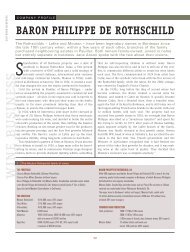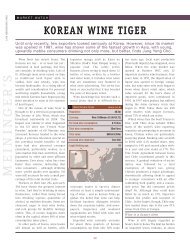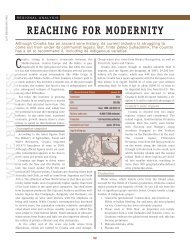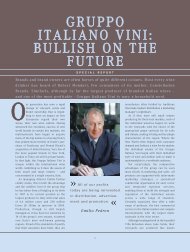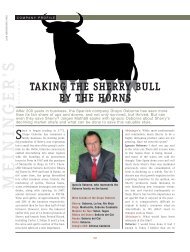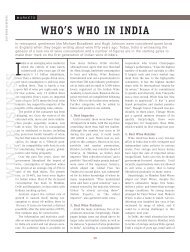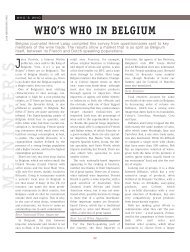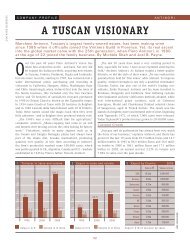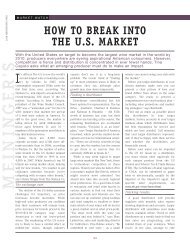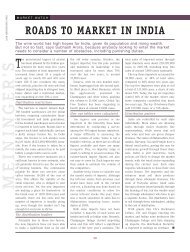AUSTRIA: SMALL AND SEDUCTIVE - Wine Business International
AUSTRIA: SMALL AND SEDUCTIVE - Wine Business International
AUSTRIA: SMALL AND SEDUCTIVE - Wine Business International
Create successful ePaper yourself
Turn your PDF publications into a flip-book with our unique Google optimized e-Paper software.
<strong>AUSTRIA</strong>:<br />
<strong>SMALL</strong> <strong>AND</strong> <strong>SEDUCTIVE</strong><br />
A U S T R I A<br />
S P O N S O R E D P R O F I L E<br />
Austria’s stunning success in markets like the United States, Germany, Switzerland and the Netherlands is<br />
all the more remarkable if one considers the small size and fragmented structure of this Alpine<br />
coun try. For the first time in history, exports exceeded the mark of €100m. Such success, though, is no<br />
accident. Grüner Veltliner and company have been being skilfully positioned as niche products: new, sexy and<br />
full of character, but by no means too fancy. Austria’s wines are perfect for innovative wine merchants, trendy<br />
wine bars and ambitious sommeliers from Tokyo to Los Angeles. In times of global production and interchangeable<br />
profiles, this is a clever strategy that promises great payoffs in the long term.<br />
“When speaking of the growth<br />
of Austrian wine in Norway, I believe<br />
‘booming’ is the right word to use.”<br />
Arne Ronold, Journalist and MW, Norway
<strong>AUSTRIA</strong>: <strong>SMALL</strong> <strong>AND</strong> <strong>SEDUCTIVE</strong><br />
<strong>AUSTRIA</strong><br />
S P O N S O R E D P R O F I L E<br />
2007 was a watershed year for Austrian wine exports. Not only did value surpass the magical<br />
€100m barrier for the first time in history, but the majority all Grüner Veltiner, Zweigelt and<br />
Blaufränkish leaving the alpine country now does so in bottle, not bulk. Since the Millenium, the<br />
volume of bottle wine in the export mix has risen 147%, value by 161% and the average price per<br />
litre by 168%. A finely focused strategy on quality is obviously now beginning to bear fruit.<br />
Even the Austrian <strong>Wine</strong> Marketing<br />
Board, better known as ÖWM in the<br />
wine world, was visibly surprised by the<br />
final statistics. In early January, general<br />
director Willi Klinger and his staff were still<br />
expecting total exports to remain slightly<br />
below the €100m mark. Even that would<br />
have been a new record, but it turned out<br />
much better. Owing to a remarkably strong<br />
December, value soared to €105m, of which<br />
€92m stemmed from bottled wine exports.<br />
In order to correctly interpret these<br />
numbers, a survey of past results is of use<br />
here. Exports in 2000 came to the modest<br />
sum of €40m, with an average price per<br />
litre of only €1.12. Even if you deduct the<br />
inexpensive bulk wines, bottled wines still<br />
weighed in at only €2.24. Today the<br />
average price is €1.88. For bottled wine exports,<br />
that number has risen €2.57 per litre<br />
or €3.42 per 0.75 litre bottle.<br />
In other words: Austria has increased exports<br />
by 56% since 2000, pushing up bottled<br />
volume by 147% and value by 161%. The<br />
average price per litre rose by 168%. Impressive<br />
numbers, but what are the reasons<br />
for Austria’s export success A combination<br />
of factors, with quality, obviously, heading<br />
the list. Without quality, such an increase<br />
in volume and, more importantly, in value<br />
would never have been possible.<br />
FACTOR 1:<br />
QUALITY<br />
A1<br />
mong experts, Austria’s wines have<br />
enjoyed a high level of appreciation for<br />
many years, but this was not always the<br />
case. In the 1990s, a great deal of persuasion<br />
was required to move attention beyond<br />
the loyal circle of domestic imbibers and<br />
convince wine lovers abroad of the quality<br />
of Austrian wines. To do so, the ÖWM<br />
availed itself in the late 1990s of a means<br />
still quite popular today: it invited journalists<br />
and sommeliers to attend a comparative<br />
tasting of the finest 1995 Grüner Veltliners<br />
with a similar number of hand-picked<br />
Burgundies from the same vintage. The<br />
Grüner Veltliners took all three top prizes.<br />
Members of the foreign press, insofar as<br />
they had not participated in the tasting<br />
themselves, greeted the initial outcome<br />
with understandable scepticism. Later,<br />
though, similar tastings corroborated the<br />
results. In 2002, the ultimate accolades<br />
followed in London when Jancis Robinson<br />
requested that the duel be restaged. This<br />
time, though, the tasting took place according<br />
to her rules. There were no constraints<br />
on vintage, and the team of white<br />
Burgundies was enhanced by renowned<br />
Chardonnays from Italy as well as the New<br />
World. The result caused a stir when first<br />
place went to the 1990 “Vinothekfüllung”<br />
from Emmerich Knoll, followed by the 1997<br />
Lamm from Willi Bründlmayer. In third<br />
place was the Velich Tiglat Chardonnay<br />
1997, also from Austria. Seven Austrian<br />
wines, including five Grüner Veltliners,<br />
numbered among the top ten.<br />
From then on, Austria received plenty of<br />
attention from the English trade press.<br />
There was still a long way to go, though,<br />
before that conceptual breakthrough could<br />
be translated into sales in markets such as<br />
Great Britain and the United States.<br />
Ironically, while Austria won the press<br />
with its lush Grüner Veltliners of Burgundian<br />
style, the country owes its triumphant<br />
breakthrough and sustained success in ex-<br />
II
Grüner Veltliner: fingerprint of the<br />
Austrian wine trade<br />
Except in Styria and the southern Burgenland,<br />
this flagship grape is well represented in all<br />
Austrian wine regions. Its peppery piquancy is<br />
a leitmotif for all the individual types. Here is a<br />
short survey:<br />
Weinviertel: The most peppery type of them<br />
all, with lively crispness and apple fruit and<br />
partial floral accents.<br />
Kamptal and Wagram: Preponderantly<br />
shaped by the loess soils, with full fruit touching<br />
on the exotic. When picked at full maturity,<br />
quite a bit like a Burgundy.<br />
Wachau: The firmest Grüner Veltliner, moulded<br />
by terraced rocky soils, with clear minerality. In<br />
addition, citrus to stone fruit aromas.<br />
Kremstal and Traisental: The two regions<br />
with the greatest stylistic diversity, ranging<br />
from the prehistoric rock type from the<br />
Wachau to the typical Veltliner derived from<br />
loess soils.<br />
Northern Burgenland: The most exciting<br />
Grüner Veltliners of the Burgenland grow on<br />
the west bank of the Neusiedler Sea on the<br />
chalky, slate slopes of the Leitha mountains.<br />
Veltliners with a subtle minerality, mild acidity<br />
and Burgundian accents thrive here.<br />
port markets to its fresh, light and lively<br />
Grüner Veltliners and, not to be forgotten,<br />
its autochthonous red wines, Zweigelt und<br />
Blaufränkisch. Specialties like Riesling from<br />
the Danube as well as Sauvignon Blanc and<br />
Gelber Muskateller, stemming originally<br />
from Styria, have slowly established themselves<br />
all across Austria and now reign<br />
supreme, particularly on the domestic<br />
market. Their counterparts in the red wine<br />
segment are Sankt Laurent and Pinot Noir.<br />
Excellent conditions are to be found for both<br />
in the wine country of the Thermenregion,<br />
Burgenland and north of the Danube as<br />
well, all yielding excellent wine.<br />
FACTOR 2:<br />
<strong>AUSTRIA</strong>N<br />
WINE AS A<br />
NICHE<br />
PRODUCT<br />
I2<br />
n spite of the enormous diversity of<br />
domestic grapes, when it comes to<br />
exports, Austria is defined principally by its<br />
three major grapes: Grüner Veltliner,<br />
Zweigelt and Blaufränkisch, which together<br />
cover more than half of its vineyards. With<br />
an annual production of just over 250m<br />
litres, such concentration has proven itself<br />
a prudent decision, the more so as the three<br />
grapes occupy highly interesting niches in<br />
the global wine portfolio.<br />
Owing to its distinct pepperiness, combined<br />
with a charming fruit, Grüner Veltliner<br />
has a one-of-a-kind profile. Depending<br />
on microclimate, soil and the maturity of<br />
the grapes at the time of the picking, styles<br />
range from apple to opulent exotic fruit. Its<br />
acidity is less pronounced than Riesling,<br />
but even when picked at full ripeness,<br />
Grüner Veltliner nearly always shows a distinct<br />
crispness – and crispness is certainly<br />
one of the factors that has made Austria’s<br />
red wines, based on Zweigelt and Blau frän -<br />
kisch, a cut above the international standard.<br />
Moreover, both grapes boast a decided<br />
fruitiness, which pairs quite well with<br />
current consumer tastes in many countries.<br />
Depending on the flavour profile desired,<br />
the choice is between the more richly<br />
tannic and structured Blaufränkisch or the<br />
more accessible Zweigelt.<br />
above left: Unmistakeably spicy Grüner Veltliner.<br />
above right: Austria’s wine landscapes, as here<br />
in Styria, are certainly some of the most beautiful<br />
in the world.<br />
left: The winery of Gernot Heinrich in Gols.<br />
III
<strong>AUSTRIA</strong>: <strong>SMALL</strong> <strong>AND</strong> <strong>SEDUCTIVE</strong><br />
FACTOR 3:<br />
PROFILES<br />
OF ORIGIN<br />
T3<br />
he current discussion about the distinct<br />
profile of individual regions is<br />
nothing more than the logical result of the<br />
rapid enhancement of quality that has<br />
occurred in recent years. Technically, Austria’s<br />
wines have long been beyond<br />
reproach. Even in the basic range, they<br />
have always shown pure varietal character.<br />
Thus, Austria’s wine trade decided to<br />
develop profiles of origin. On 1 March<br />
2003, the first controlled designation entitled<br />
Weinviertel Districtus Austriae Controllatus,<br />
or Weinviertel DAC, broke<br />
ground. Target To improve the image of<br />
the Grüner Veltliner typical for the Weinviertel<br />
and to better acquaint consumers<br />
with its inimitable peppery taste profile.<br />
Since then, the volume of Grüner Veltliner<br />
sold as Weinviertel DAC has risen year for<br />
year, a confirmation for all those who,<br />
from the beginning, campaigned for marketing<br />
the origin. Nonetheless, after the<br />
launch of Weinviertel DAC, it took time<br />
before the process gathered steam. Then,<br />
over the course of the past two years, further<br />
developments followed rapidly: Mittelburgenland<br />
became the first red wine<br />
region to step toward controlled origins<br />
with its Blaufränkisch. Moreover, a second<br />
tier of quality was established with<br />
the additional designation of “Reserve”.<br />
Meanwhile, the Traisental, which is<br />
only barely known outside Austria, and its<br />
more renowned northern neighbour, the<br />
Kremstal, made the decision to join the<br />
race. The Kremstal did so with the most<br />
complex structure so far: two grape varietals,<br />
Grüner Veltliner and Riesling, as<br />
above: The red-white-red seal is Austria’s<br />
mark of quality.<br />
upper right: <strong>Wine</strong> is cause for celebration<br />
in Austria<br />
right: Gemütlichkeit (comfort cosiness<br />
snugness) is hard to translate, but an integral<br />
part of Austrian culture.<br />
IV
well as two quality levels, Kremstal DAC<br />
und Kremstal DAC Reserve. It is expected<br />
that the Kamptal will soon follow with a<br />
similar structure.<br />
Whether with or without controlled origins,<br />
wines that are typical for a region -<br />
and moulded by its soils and micro climate<br />
enjoy widespread appreciation among<br />
Austria’s vineyard owners. But terroir cannot<br />
be generated in the cellar. A distinct<br />
regional character, not limited to the<br />
vagaries of climate, can only be based<br />
upon vineyard practices that are rooted in<br />
nature. Not surprisingly, many of Austria’s<br />
leading estates are in the process of<br />
converting their operations to organic or<br />
even biodynamic farming. The total organically<br />
grown vineyard area has grown<br />
in the past year by more than 40% to<br />
roughly 2,500 hectares. Around 320<br />
hectares of these are officially farmed<br />
biodynamically.<br />
Of course, not all wineries are on this<br />
path, but even those who farm their vineyards<br />
“conventionally” do so in an environmentally<br />
sound, sustainable fashion<br />
and are addressing that pivotal question:<br />
“How do I ensure that the vineyard’s character<br />
is reflected in my wine”<br />
This sort of production, both natural<br />
and artisanal in the best sense, is a vital<br />
part of the puzzle in positioning Austrian<br />
wine as a niche product. “Natural instead<br />
of commercial, artisanal instead of industrial,<br />
family owned and operated companies<br />
instead of corporate groups, full of<br />
character instead of uniformity, based on<br />
nature instead of technology.” With this<br />
strategy, Austria has secured for itself a<br />
piece of the global wine pie. Even the few<br />
larger operations like the Winzer Krems<br />
or Lenz Moser are, when compared to<br />
their internationally brethren, down-toearth<br />
family companies.<br />
Gerhard Elze,<br />
ÖWM:<br />
“The consistent<br />
labour that<br />
Austrian growers<br />
devoted to the wine<br />
trade in Germany,<br />
even in bad times,<br />
is now bearing<br />
fruit!”<br />
V
<strong>AUSTRIA</strong>: <strong>SMALL</strong> <strong>AND</strong> <strong>SEDUCTIVE</strong><br />
<strong>AUSTRIA</strong><br />
S P O N S O R E D P R O F I L E<br />
No wine growing region is more than two hours drive from Vienna, the country’s cultural<br />
centre. A quarter of the population lives in the capital, feasting on a surprisingly colourful<br />
media and remarkable culinary landscape. It is no coincidence that the revolution in crystal<br />
stemware traces its origins back to Austria. This environment has enabled ambitious winemakers<br />
to gain nationwide prominence and build a market for their wines in only a few years.<br />
FACTOR 4:<br />
GOURMET<br />
COUNTRY<br />
<strong>AUSTRIA</strong><br />
T4<br />
he rapid and, above all, sustained<br />
quality growth in the Austrian wine<br />
scene has a great deal to do with the physical<br />
characteristics of the country: With a<br />
total land mass of only 84,000 square kilometres,<br />
roughly one-fourth the size of Germany,<br />
Austria is a small country. No wine<br />
growing region is more than two hours<br />
from Vienna, the country’s cultural and<br />
social centre. Not only does a quarter of<br />
the population reside in the capital, but<br />
there is a surprisingly colourful media<br />
landscape there that boasts a plethora of<br />
wine and gourmet publications. Even the<br />
daily press and television stations devote<br />
lots of space to food and wine. There is<br />
hardly any other country so orientated towards<br />
enjoyment as the Austrians – and<br />
their culinary level is remarkably high. It<br />
is no coincidence that the revolution in<br />
glass culture at the dining table traces its<br />
origins back to Austria. <strong>Wine</strong> as a means<br />
for enjoyment is firmly anchored within<br />
Austrian society. Today it is de rigueur to<br />
be wine literate and seminars at the Austrian<br />
<strong>Wine</strong> Academy have boomed.<br />
This environment has enabled young,<br />
ambitious winemakers to gain nationwide<br />
prominence in only a few years and build<br />
a corresponding market for their wines.<br />
Their geographical proximity to one another<br />
has resulted in an intensive<br />
exchange between growers. Such a competitive<br />
environment means producers<br />
can’t slacken in their efforts - and that<br />
lends a peerless dynamism to Austria’s<br />
wine trade. This is highlighted by the<br />
astounding volume and diversity of new,<br />
state-of-the-art wineries. A veritable feast<br />
in wine architecture! The proof A widely<br />
acclaimed exhibition dedicated to the subject<br />
has been running in the United States<br />
since September of last year.<br />
upper right: In spite of their sophistication,<br />
Austria’s winemakers remain attached to the soil.<br />
right: Public magnet, the Loisium in Kamptal.<br />
VI
D5<br />
espite the stable domestic market, Austria’s<br />
wine producers neither want nor<br />
can they rely on the eternal loyalty of their<br />
compatriots or the numerous holiday guests<br />
who contribute to the high total Austrian<br />
wine consumption. A healthy export ratio of<br />
one third now ensures additional stability to<br />
the red-white-red, named after the colours<br />
in Austria’s flag, wine trade.<br />
Even as late as 2003, the situation was<br />
hardly satisfactory. Of the exported 85m<br />
litres, more than 60m left the country in<br />
bulk, mainly to be processed into sparkling<br />
wine. Germany (63%) and the Czech Republic<br />
(25%) were the main buyers. Italy, too,<br />
stocked up on commodity bulk. Other than<br />
that, only Switzerland (1.3% in volume, but<br />
Evolution of Austrian bottled<br />
wine exports 2004 to 2007<br />
27,423<br />
2.35<br />
32,412<br />
2.05<br />
in ‘000,000 litres<br />
average price in €<br />
28,649<br />
2.42<br />
35,806<br />
2.57<br />
2004 2005 2006 2007<br />
FACTOR 5:<br />
EXPORT<br />
STRATEGY<br />
6.2% in value), the United States (0.8% of<br />
volume, but 5.7% in value) and Poland, as<br />
yet another buyer of bulk for sparkling<br />
wine, could have been designated as serious<br />
export markets. All the other major importing<br />
countries, such as Great Britain,<br />
Scandinavia, the Netherlands and Russia,<br />
Daniel Hubbard,<br />
Domaine Select<br />
<strong>Wine</strong> Estate:<br />
“Not only in the<br />
classical strongholds<br />
even in Washington,<br />
Oregon and<br />
Tennessee, the demand<br />
for Austrian<br />
wine is on the rise.”<br />
VII
<strong>AUSTRIA</strong>: <strong>SMALL</strong> <strong>AND</strong> <strong>SEDUCTIVE</strong><br />
moved Austrian wines in homeopathic<br />
doses. with their export shares being less<br />
than 0.1%.<br />
By the end of 2007, exports looked<br />
entirely different, as becomes clear when the<br />
major markets are examined.<br />
Germany: Change of course<br />
Germany was, is and will remain by far<br />
the most significant export market for Austrian<br />
wines. Here, though, a remarkable<br />
change has taken place in recent years. In<br />
2003, the import ratio was two-thirds bulk<br />
to one-third bottled wine. Today, it is just the<br />
opposite. At the same time, the average price<br />
of both imported bottled as well as bulk<br />
wines has risen noticeably. In Bavaria,<br />
Grüner Veltliner has soared so high as to become<br />
a serious alternative to the Italian<br />
Pinot Grigio. In other words, at least in<br />
Bavaria, Grüner Veltliner has firmly established<br />
itself in the major leagues; indeed it<br />
ranks in the top third of the charts. In the<br />
wake of Grüner Veltliner, Zweigelt enjoyed<br />
Bottled wine exports<br />
to Germany<br />
21,472<br />
1.84<br />
23,711<br />
in ‘000,000 litres<br />
average price in €<br />
22,215<br />
25,314<br />
1.57 1.73 2.00<br />
2004 2005 2006 2007<br />
similar growth and now hardly trails behind<br />
its white counterpart in popularity and<br />
prominence. Two further strongholds of Austrian<br />
wine lie in Germany’s north: Hamburg<br />
and Berlin. There,Grüner Veltliner has<br />
gained a firm position on the wine lists of<br />
the upmarket gourmet temples, as well as<br />
conquering a secure spot on the menus of<br />
young, modern, international reataurants.<br />
This was an ideal starting point to conquer,<br />
on a step by step basis, the rest of the<br />
country. The rapidly growing interest of the<br />
large food retailers attests to the greatly<br />
burnished image of Austrian wine. Both<br />
Lenz Moser and Winzer Krems, Austria’s<br />
largest players in the German trade, have<br />
reported rising sales, in particular in the<br />
premium sector. Friedrich Wimmer, marketing<br />
head for Lenz Moser, is happy about the<br />
development: “A large part of last year’s 14%<br />
growth is due to increasing demand for our<br />
two top lines.” In the specialised trade sector<br />
and in gastronomy, Austria is gaining momentum,<br />
too: “We started early with Austria<br />
and that is now paying off,” is how Rudolf<br />
Knickenberg, general manager of the importer<br />
Schlumberger, explains his experience.<br />
Conversely, Oliver Thieme, managing<br />
director of competitor CWD, the specialised<br />
importer of the market leader in the mailorder<br />
sector, Hawesko, regrets not having<br />
Bottled wine exports<br />
to Switzerland<br />
697<br />
7.06<br />
1,008<br />
6.65<br />
average price in €<br />
1,201<br />
7.44<br />
in ‘000,000 litres<br />
1,562<br />
6.30<br />
2004 2005 2006 2007<br />
above: Perfect style: the tasting room at the<br />
Neumeister estate in Styria.<br />
upper right: Vienna and wine: the capital not<br />
only has its own vineyards, but all other wine<br />
growing regions are within a two hour drive.<br />
right: The winery of J. Heinrich in Deutschkreutz,<br />
Mittelburgenland.<br />
VIII
stuck with Austria: “Five years ago we made<br />
an attempt with a broad product range, but<br />
gave up too early. If we had followed<br />
through, we would have built strong brands<br />
that sell by now.”<br />
“Gastronomy, specialised trade and the<br />
upmarket retail food trade remain the most<br />
important partners in the distribution of Austrian<br />
wines. It may be observed, though, that<br />
even the discount trade is taking Austrian<br />
wine seriously and now offers a Grüner Veltliner<br />
to the consumer for about €4,” explains<br />
Gerhard Elze (ÖWM), betting on continuity.<br />
There had been concerns in Austria that the<br />
growing popularity of German wines on the<br />
domestic market might turn out to be a stumbling<br />
block for Austria, but the very opposite<br />
is true. “Both styles of wine may be similar,<br />
but they are autonomous and complement<br />
each other well”, according to Elze. In fact,<br />
taste in Germany today goes toward fruit and<br />
crispness, so it ends up being more or less a<br />
home game for Austria.<br />
Switzerland: Red wines<br />
ahead by a nose<br />
As an export market for bottled Austrian<br />
wine, Switzerland has long been the uncontested<br />
number two after Germany – and<br />
since 2004, this market has been booming.<br />
Volume and value have nearly doubled in<br />
Bottled wine exports<br />
to the United States<br />
868<br />
5.58<br />
985<br />
5.74<br />
average price in €<br />
1,284<br />
5.48<br />
in ‘000,000 litres<br />
1,487<br />
5.26<br />
2004 2005 2006 2007<br />
that short time and, since 2000, almost<br />
tripled. What distinguishes Switzerland<br />
from all other major export markets is the<br />
predominance of red wines, but that is<br />
something Markus Nauer from Nauer Weine<br />
does not wish to overstate. He is one of the<br />
experts for Austrian wines in Switzerland,<br />
selling to both private customers and the<br />
catering trade: “Basically all wines are<br />
sought after – red, white and dessert wine –<br />
provided they are of a certain standard. For<br />
all practical purposes, you cannot sell a bottle<br />
for under 10 Swiss francs, with the<br />
largest sales attained in the range from 13<br />
to 18 francs. These are offered on-trade by<br />
the glass - and increasingly, consumers are<br />
stocking up on high quality products. Most<br />
know the Wachau, perhaps Burgenland and<br />
Bottled wine exports<br />
to the Netherlands<br />
191<br />
3.73<br />
620<br />
in ‘000,000 litres<br />
1.85<br />
609<br />
4.84<br />
average price in €<br />
1,404<br />
3.91<br />
2004 2005 2006 2007<br />
possibly Styria. All other regions are unknown,<br />
but that doesn’t apply to the wines.”<br />
Around 400 wineries are currently represented<br />
by 200 importers. “In Switzerland,<br />
we are riding an enormous wave of<br />
sympathy. The Swiss appreciate good wine<br />
and they find it in ours,” says Susanne<br />
Staggl (ÖWM), quite pleased with the current<br />
development.<br />
USA: ‘Gruner’ is en vogue<br />
There are thousands of glamorous, modern<br />
restaurants in New York – and every<br />
self-respecting sommelier has a formidable<br />
selection of wines on offer. Among them,<br />
ten or twelve are served by the glass. These<br />
are the wines that sell particularly well, and<br />
among their number you will find with conspicuous<br />
frequency a Grüner Veltliner. “For<br />
the past couple of years, the United States<br />
Markus Nauer,<br />
Nauer Wein:<br />
“Consumers know<br />
the Wachau, perhaps<br />
the Burgenland<br />
and possibly<br />
Styria. All other regions<br />
are unknown,<br />
but that doesn’t<br />
apply to the wines.”<br />
IX
<strong>AUSTRIA</strong>: <strong>SMALL</strong> <strong>AND</strong> <strong>SEDUCTIVE</strong><br />
<strong>AUSTRIA</strong><br />
S P O N S O R E D P R O F I L E<br />
In the beginning, the Austrian <strong>Wine</strong> Marketing Board chose to emphasize only upmarket wines<br />
in the United States. In relation to value, volumes were homeopathic for over ten years. Now the<br />
market is ready for wines with broader appeal - and the results are impressive. Since 2000, the<br />
volume of wine exported to America has quintupled and value quadrupled. In New York, ‘Grüner’<br />
has almost cult status. Even at $30 a bottle, they are viewed as excellent value for money.<br />
has been nothing less than a fairy tale success<br />
story. Last year we reached six digit volumes<br />
in exports to the United States for the<br />
first time, and it appears that another jump<br />
in volume is still in the cards for this year,”<br />
according to Ludwig Holzer, who adds: “Further,<br />
we are moving at a different price level<br />
here than in Europe.”<br />
Willi Klinger, the head of ÖWM, who is<br />
personally overseeing the American market,<br />
views that as a confirmation that the chosen<br />
strategy was the right one: “In the beginning,<br />
we were consciously offering highpriced<br />
products; in relation to volume, it was<br />
pure homeopathy for ten years. Now the<br />
American market is ready for wines with<br />
broader appeal, like a Hugo or Lois.” To a certain<br />
degree, the whole thing runs along the<br />
line of ‘Grüner Veltliner, the better Pinot Grigio’,<br />
as one hears from importers. Naturally<br />
the average price is incrementally declining<br />
as the market grows, but we’re still moving<br />
on quite a good level.”<br />
The numbers are impressive. Since 2000,<br />
the volume exported to the United States has<br />
quintupled and value quadrupled. Besides<br />
New York, where the “Gruner” has near cult<br />
status, Austria has made breakthroughs in<br />
other wine strongholds like Chicago, Boston,<br />
Florida and California. And not just there: “In<br />
Washington, too, in Oregon and even in<br />
Tennessee, the demand for wine from Austria<br />
is on the rise,” reports Daniel Hubbard from<br />
Domaine Select <strong>Wine</strong> Estate. His company has<br />
been importing Austrian wines since 2003.<br />
“With the 2005 vintage, business really got<br />
going and, for the first time, we sold faster<br />
than expected. In 2006 there was another<br />
fantastic increase. Right now, Austria is succeeding<br />
on two levels. First, we have affordable,<br />
modern, brand-like wines sold for $10<br />
that are capable of introducing Austrian wines<br />
to a new audience. Secondly, we have wines<br />
for the upmarket sector, which may very well<br />
cost $20 or even $30, but are persuasive by<br />
their excellent value for money.”<br />
The Netherlands<br />
“The Netherlands is slowly learning that<br />
Austria is not just mountains and snow.<br />
The enthusiasm among wine lovers is<br />
Bottled wine exports<br />
to the United Kingdom<br />
211<br />
Bottled wine exports<br />
to Scandinavia<br />
908<br />
Bottled wine exports<br />
to Poland<br />
389<br />
126<br />
85<br />
109<br />
in ‘000,000 litres<br />
13.26<br />
17.88<br />
9.16<br />
11.75<br />
average price in €<br />
2004 2005 2006 2007<br />
384<br />
322<br />
246<br />
in ‘000,000 litres<br />
5.66<br />
5.25<br />
5.43<br />
average price in €<br />
4.20<br />
2004 2005 2006 2007<br />
65<br />
62<br />
50<br />
3.46<br />
in ‘000,000 litres<br />
average price in €<br />
2.99<br />
2.92 2.94<br />
2004 2005 2006 2007<br />
right: Erich Scheiblhofer’s powerful wines<br />
embody an international style<br />
X
Progression of export sales from 2000 to 2007 in ‘000 litres<br />
34,978<br />
55,082<br />
27,230<br />
21,353<br />
22,719<br />
19,497<br />
32,411<br />
16,558<br />
14,491 Bottles<br />
2000 2001 2002 2003 2004 2005 2006 2007<br />
Development of biological wines in Austria from 2000 to 2007<br />
625.2 700.6 768.9<br />
214 265 304<br />
Bulk<br />
Hectares<br />
60,713<br />
1,536<br />
huge,” says Susanne Staggl. Since 2004,<br />
exports have virtually exploded. Since<br />
then, both volume and value have grown<br />
sevenfold. A major share of this can be<br />
attributed Regina Meij and her company<br />
Imperial. “I started with Austria 13 years<br />
46,660<br />
1,657<br />
34,728<br />
Number of producers<br />
28,648<br />
23,028<br />
1,791 1,766<br />
419 467 498 469<br />
35,806<br />
20,115<br />
2000 2001 2002 2003 2004 2005 2006 2007<br />
Bottled wine exports<br />
to Canada<br />
143<br />
2.67<br />
52<br />
4.61 4.67<br />
average price in €<br />
96 92<br />
in ‘000,000 litres<br />
5.42<br />
2004 2005 2006 2007<br />
2,477<br />
ago. That was initially ground breaking<br />
labour, but I was persuading customers<br />
with quality. Although that’s the only way<br />
to establish a durable image, it requires<br />
time. I chose the path via upmarket gastronomy,<br />
a top-down approach, so to speak.<br />
The people who tasted the wines are sticking<br />
with them. They are certainly not inexpensive,<br />
but for that type of premium<br />
quality, they still offer value for money. In<br />
the meantime, Austria has arrived in the<br />
middle market, too. Owing to that fact, volumes<br />
are soaring. Now the specialised<br />
trade and retail food trade are becoming<br />
interested. Importers with an international<br />
product range are adopting Austrian wines<br />
as well. If I say today that I import wine<br />
from Austria, their response is: ‘Ah, yes,<br />
Grüner Veltliner.’ This style of wine is now<br />
quite hot in the catering trade.”<br />
Emerging Markets<br />
The four largest export markets are not<br />
alone in providing dynamism to the export<br />
balance. The ‘future markets’, too, are<br />
bringing joy to the Austrians.<br />
The combined Scandinavian markets<br />
now move on par with the Netherlands.<br />
“When speaking of the growth of Austrian<br />
wine in Norway, I believe ‘booming’ is the<br />
right word to use,” says Arne Ronold, journalist<br />
and MW, describing the rapid rise of<br />
the wines with the red-white-red seal in<br />
Norway. “In 1999 total sales of Austrian<br />
wines through Vinmonopolet amounted to<br />
only 7,000 litres. In 2007 that figure rose<br />
to 288,000 litres, more than 40 times more<br />
than eight years ago! Of this, 89% is white<br />
wine, dominated by Grüner Veltliner and<br />
Riesling. Schilcher takes the remaining<br />
11%. While sales of Austrian red wines are<br />
insignificant, sales of white wines through<br />
the monopoly rose by 124% from 2006 to<br />
2007 – and this trend is continuing into<br />
2008. Among the restaurants, many of the<br />
finest ones, including Bagatelle, Feinschmecker<br />
and Statholdgaarden, are listing<br />
premium white wines from Austria and I<br />
believe they are quite successful.”<br />
The dynamism in Sweden and Denmark<br />
took the cake last year, with a jump in import<br />
volumes of 134%. In Denmark, even the retail<br />
food trade has adopted a growing fondness for<br />
Regina Meij,<br />
Imperial,<br />
Netherlands:<br />
“Grüner Veltliner is<br />
very successful by<br />
the glass in restaurants<br />
in the Netherlands.<br />
The people<br />
who taste them then<br />
stick with them.”<br />
XI
<strong>AUSTRIA</strong>: <strong>SMALL</strong> <strong>AND</strong> <strong>SEDUCTIVE</strong><br />
Austrian wine. That, as a rule, is an unmistakable<br />
signal that a breakthrough is on the horizon.<br />
For years, Great Britain ignored the<br />
overtures of Grüner Veltliner and company. In<br />
the past two, though, there have been clear signals<br />
that this “resistance” is fading. Distribution<br />
in the upper segment of the catering trade<br />
is on a spree and the number of listings in the<br />
off-trade is rising. “Very slowly, consumers in<br />
Great Britain are climbing on the bandwagon,<br />
too, succumbing to a certain Austrian euphoria,<br />
which had already existed in the press for<br />
years,” says Susanne Staggl (ÖWM).<br />
If you keep your ears open on the Austrian<br />
slopes, you quickly realize that Russia is a<br />
genuine future market for Austrian wines.<br />
“Tourism, especially in the winter, shapes an<br />
awareness of wine from Austria,” ÖWM<br />
associate Christian Dworan confirms. In Austria’s<br />
top hotels, Russian guests are learning<br />
that there are premium Austrian wines. “The<br />
demand for prestige products in Russia is<br />
enormous. The wine market there, though, is<br />
still fiercely contested,” according to Dworan.<br />
Exports to Russia hardly reflect the true conditions<br />
of the market, as grey market imports<br />
via third countries are not registered.<br />
The red and white of export markets<br />
Germany<br />
Netherlands<br />
UK<br />
Scandinavia<br />
Poland<br />
Switzerland<br />
USA<br />
Canada<br />
Russia<br />
Total<br />
4.4%<br />
61.5%<br />
56.3%<br />
82.4%<br />
77.1%<br />
36.4%<br />
71.4%<br />
64.1%<br />
57.9%<br />
59.0%<br />
As well as through Germany and the<br />
Netherlands, there is probably the occasional<br />
litre of Austrian wine finding its way<br />
to Moscow on the parallel market through<br />
Poland. Incredible as it sounds, export volumes<br />
to Poland have risen sevenfold from<br />
2006 to 2007. Like elsewhere, a leisure class<br />
has been forming in Polish cities – and they<br />
are stalwart wine aficionados, causing the<br />
average price of bottled Austrian imports,<br />
red and white alike, to jump from €2.87 to<br />
€4.48 last year. Bulk red wines also had<br />
their share in the exponential market<br />
growth, with their volume shooting from<br />
zero to 350,000 litres, at a remarkable average<br />
price of just under €2.80 per litre.<br />
That said, Austria has not managed to<br />
make a breakthrough everywhere. At least<br />
not yet. Canada remains a headache. “We<br />
simply haven’t made any real progress,” reports<br />
ÖWM head Willi Klinger and Ludwig<br />
Holzer, export manager with Winzer Krems,<br />
in similar tones: “Although we've been active<br />
in Canada for thirty years, growth there has<br />
been stagnant over the last ten years. Compared<br />
to the United States, it’s a difference<br />
of day and night.”<br />
38.5%<br />
43.7%<br />
17.6%<br />
22.9%<br />
95.6%<br />
63.6%<br />
28.6%<br />
35.9%<br />
42.1%<br />
41.0%<br />
above: The Kremstal has its own DAC since 2008.<br />
Asia, too, currently takes little notice of<br />
Austrian wine. “There are auspicious beginnings<br />
and a number of potential buyers”,<br />
says Klinger, who senses an opportunity he<br />
would like to seize upon with the tried and<br />
tested strategy: “We will go into the catering<br />
trade there with our premium wines<br />
and work our way down.” Along the lines of:<br />
“What has worked in the United States,<br />
Switzerland and the Netherlands will not go<br />
wrong in Asia.” If it ain’t broke, don’t fix it,<br />
appears to be a safe assumption.<br />
Willi Klinger, ÖWM:<br />
“The paradigm shift is<br />
remarkable. We began<br />
selling rich, succulent<br />
and mature wines.<br />
Today the market is<br />
also open for classically<br />
crisp and lively<br />
Austrian wines.”<br />
Meininger’s <strong>Wine</strong> <strong>Business</strong> <strong>International</strong> Dossier<br />
with the help of the Austrian <strong>Wine</strong> Marketing Board<br />
Text: Sascha Speicher<br />
Photos: Faber & Partner, Lehmann, ÖWM<br />
Artwork and layout: direct-agentur.de<br />
XII<br />
<strong>AUSTRIA</strong>N WINE DOSSIER<br />
WITH THE HELP OF THE GERMAN WINE INSTI-<br />
TUTE<br />
TEXT: SASCHA SPEICHER<br />
PHOTOS: LEHMANN, FABER & PARTNER, ÖWM<br />
LAYOUT: DIRECT-AGENTUR.DE




